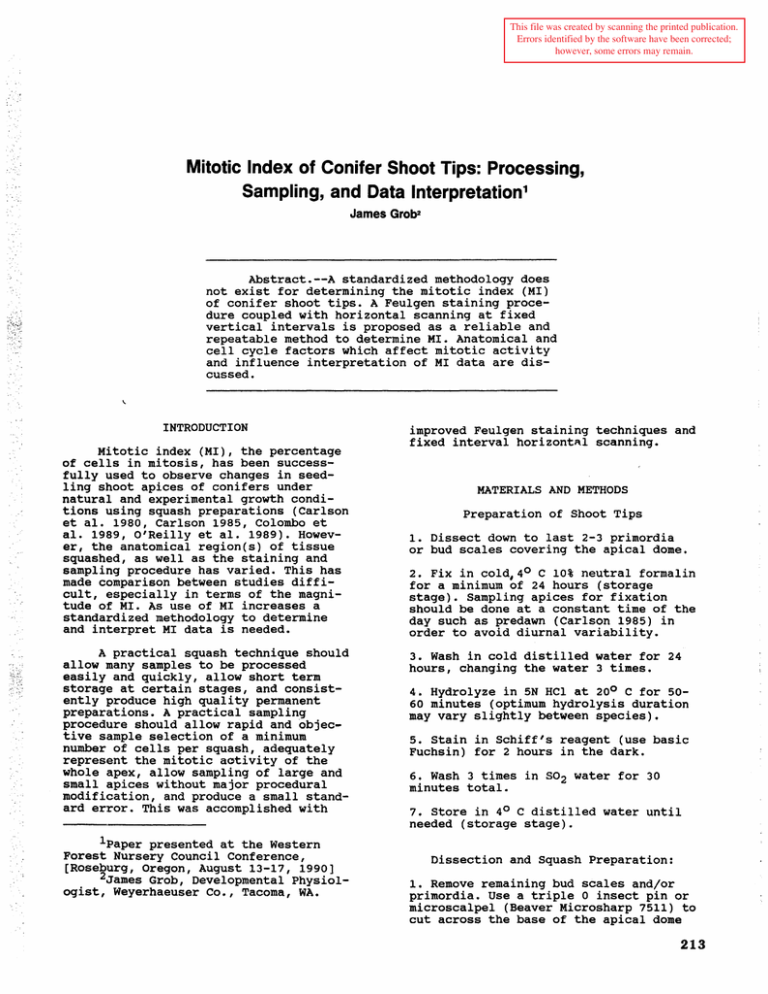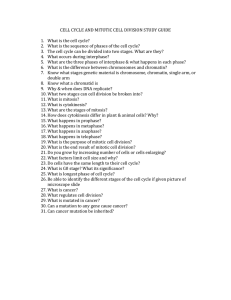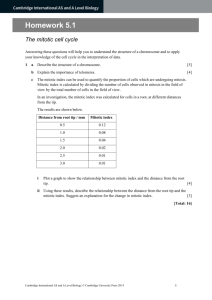Mitotic Index of Conifer Shoot Tips: Processing,
advertisement

This file was created by scanning the printed publication. Errors identified by the software have been corrected; however, some errors may remain. Mitotic Index of Conifer Shoot Tips: Processing, Sampling, and Data lnterpretation 1 James Grob2 Abstract.--A standardized methodology does not exist for determining the mitotic index (MI) of conifer shoot tips. A Feulgen staining procedure coupled with horizontal scanning at fixed vertical intervals is proposed as a reliable and repeatable method to determine MI. Anatomical and cell cycle factors which affect mitotic activ~ty and influence interpretation of MI data are d~s­ cussed. INTRODUCTION Mitotic index (MI), the percentage of cells in mitosis, has been successfully used to observe changes in seedling shoot apices of conifers under natural and experimental growth conditions using squash preparations (Carlson et al. 1980, Carlson 1985, Colombo et al. 1989, O'Reilly et al. 1989). However, the anatomical region(s) of tissue squashed, as well as the staining and sampling procedure has varied. This has made comparison between studies difficult, especially in terms of the magnitude of MI. As use of MI increases a standardized methodology to determine and interpret MI data is needed. A practical squash technique should allow many samples to be processed easily and quickly, allow short term storage at certain stages, and consistently produce high quality permanent preparations. A practical sampling procedure should allow rapid and objective sample selection of a minimum number of cells per squash, adequately represent the mitotic activity of the whole apex, allow sampling of large and small apices without major procedural modification, and produce a small standard error. This was accomplished with 1paper presented at the Western Forest Nursery Council Conference, [Roseburg, Oregon, August 13-17, 1990] 2James Grob, Developmental Physiologist, Weyerhaeuser Co., Tacoma, WA. improved Feulgen staining techniques and fixed interval horizontRl scanning. MATERIALS AND METHODS Preparation of Shoot Tips 1. Dissect down to last 2-3 primordia or bud scales covering the apical dome. 2. Fix in cold,4° C 10% neutral formalin for a minimum of 24 hours (storage stage). Sampling apices for fixation should be done at a constant time of the day such as predawn (Carlson 1985) in order to avoid diurnal variability. 3. Wash in cold distilled water for 24 hours, changing the water 3 times. 4. Hydrolyze in 5N HCl at 20° c for 5060 minutes (optimum hydrolysis duration may vary slightly between species). 5. stain in Schiff's reagent (use basic Fuchsin) for 2 hours in the dark. 6. Wash 3 times in so 2 water for 30 minutes total. 7. Store in 4° c distilled water until needed (storage stage). Dissection and Squash Preparation: 1. Remove remaining bud scales and/or primordia. Use a triple o insect pin or microscalpel (Beaver Microsharp 7511) to cut across the base of the apical dome 213 at point of insertion of the last primordium. 2. Use the microscalpel to lift apex away from remaining tissue and place in a drop of 45% acetic acid on a frosted slide. 3. Place a 22 X 22 mm coverslip over dome. Use the eraser end of a pencil to gently squash the dome without causing lateral movement of the coverslip (which can cause cell shear). 4. Place slide face up on a block of flat dry ice until frozen (approximately 30 seconds). 5. While the slide is still on the dry ice, use a fine, double edge razor blade to pry the coverslip from the slide. The squash will remain on the slide. 6. Quickly place the slide into 95% alcohol for 2-3 minutes, then 100% alcohol for 2-3 minutes. 7. While still wet with 100% alcohol mount with a new coverslip in euparal (Carolina Biological Supply). Sampling the Squash Preparation 1. Use a square ocular counting grid with defined median vertical and horizontal lines which produce a sampling point (Fig. 1). Determine the vertical distance from the top and bottom horizontal lines to the sampling point under 40X magnification (this should be around 100-200 microns). This is your vertical interval. 2. Place the top horizontal line at top of the squash and move the sampling point to left of the squash (Fig. 2). 3. Scan from left to right counting any nuclei or chromosomes which make contact with the sampling point. Do not sample brown, tannin containing cells of the pith which are often found in the center of the squash or elongate nuclei which are from the procambium. Count only one metaphase, anaphase or telophase figure per pair since both figures represent one mitosis. 4. At the end of a scan find a distinctive nucleus or mitotic figure which intersects the bottom horizontal line. Move the sampling point to this position then move it back to the left side of the squash and begin the second scan. Continue scans until the squash is completely sampled (Fig. 2). 214 MED V I . .11111111,_.................. -TOP H t-11-t.........~.... -MED H . ...................... _BOTH Figure !.--Diagrammatic representation of ocular counting grid used in horizontal scanning. The sampling point is created by the cross section of the median horizontal (MED H) and median vertical (MED V) lines of the grid. A constant vertical interval between scans is maintained by using the distance from the top or bottom horizontal lines (TOP H or BOT H) to the median horizontal line (MED H). 5. Determine MI by the following equation: MI=(# mitotic figures counted/ total cells counted) X 100. 6. When analyzing MI data statistically use the arcsin transformation to normalize the data. Do not multiply by 100 when using the arcsin transformation. To test this sampling technique 10 squash preparations of loblolly pine seedling shoot apices in free growth were sampled using a vertical sampling interval of 200 microns and then resampled at a 40 micron interval. The 40 micron interval did not sample every cell in the squash but was sufficiently intensive to determine if horizontal scanning at 200 microns was an accurate measure of MI. The effect of vertical interval on mean MI was compared using a paired t-test after arcsin transformation. RESULTS Squash preparations using the Feulgen reaction produce visually excellent, permanent preparations of nuclei and mitotic figures (Fox 1969, Greilhuber 1986). This visual clarity allows early prophase and late telophase figures to be identified. Prophase figures are identified by nuclei with visible chromosomes which in early stages appear granular with a lobed perimeter, while GRID e '-··... I • • • • • ----•~ • , • • SQUASH EDGE Figure 2.--Diagrammatic representation of sampling for mitotic index using a series of horizontal scans (Sl,S2,S3) at a fixed vertical interval. telophase figures are identified by paired asymmetrically shaped, reforming nuclei which often have a convoluted perimeter. When more than one observer is measuring MI, observers should be in visual agreement on what constitutes prophase and telophase figures. Since preparations are made permanent (Conger and Fairchild 1953), sampling to determine MI does not have to take place at the same time as squash preparation. This feature in conjunction with the two storage stages during the staining process offer considerable flexibility for preparing and sampling squashes when time is available. This is advantageous in seedling studies where other physiological parameters may require more immediate measurement. With practice, dissection and squash preparation becomes rapid and routine. Horizontal scanning at 200 micron intervals is both a rapid and objective method to determine MI. With practice a squash preparation can be measured in 5-8 minutes. The intensive 40 micron interval was time consuming, increased the number of cells counted five-fold and resulted in a insignificant difference in mean MI (Table 1). Horizontal scanning at 200 micron intervals represents an accurate method to determine the MI of loblolly pine shoot apices. An appropriate vertical interval should be determined in this way for each conifer species since differences in cell size and apex size are likely. Table !.--Mitotic index assessed by horizontal scanning at 2 vertical intervals. Vertical Mean cells Mean MI Standard interval counted/apex Error (microns) 200 40 430 2199 Paired t-test 6.42 5.99 t=1.41 .40 .23 p=.192 DISCUSSION The anatomical components of the shoot tip must be recognized when preparing squash preparations. These include the shoot apex, foliar primordia, bud scales and the shoot axis. These regions vary in the magnitude and timing of their mitotic activity during the annual cycle of growth (OWens and Simpson 1988, Fielder and owens 1989). Preparation of specific anatomical regions will avoid these difficulties. The apical dome represents the most appropriate region for squash preparation since it generally lacks the high levels of cellular tannins and vascular tissue present in other regions. Measurement of apical dome height and width 215 on freshly dissected apices before fixation provides additional information since apex size correlates with stage of development and dome activity (Fielder and Owens 1989). Mitotic index determined by horizontal scanning provides an accurate measure of the mitotic activity of the entire apex (Grab 1990). However, as MI approaches zero in winter, horizontal scanning will not be an accurate measure of when mitosis ceases. Previous studies (Carlson et al. 1980, Carlson 1985, Colombo et al. 1989) have measured MI in the most active region of the apex. This was a conservative measure of when mitosis began or ceased, but represented an inflated measure of the mitotic activity of the apex. The objectives for examining mitotic activity will determine the measurement method used. To determine when mitosis ceases, the scanning method is not necessary. The visual presence or absence of mitosis in the entire squash without determining MI is adequate. However, where relative changes in MI are required or in species such as loblolly pine which never reach a MI of zero during winter (Carlson 1985), the scanning method should be used. If desired, both MI and the presencejabsence of mitosis can be determined concurrently. The cell cycle is a fundamental concept at the cellular level. The cell cycle consists of 4 stages; two "gap" stages (G1 and G2), a period of DNA synthesis (S), and mitosis (M). Mitotic index is a useful measure because it is responsive to changes in two cell cycle parameters; the duration of the cell cycle (the time taken to proceed through G1, s, G2 and M) and the growth fraction (the proportion of the cell population proceeding through the cell cycle). Changes in cell cycle duration and the growth fraction alter interphase stages in relation to mitosis. This changes the proportion of cells in mitosis at any time t, and therefore MI (Walker 1954). G1 is a particularly important interphase stage since it is the longest cell cycle stage (Miksche 1967), and because most cells in the shoot apex accumulate in this stage during the fall and w~nter as MI reaches zero (Owens and Molder 1973, Cottignies 1979). This close relationship between MI, interphase stages and cell cycle status is the rationale for using MI as a 216 measure of seedling dormancy. When interpreting MI data these relationships should be considered. Measurement of MI complements current physiological and developmental tests of seedling quality, and will provide a useful cellular parameter to correlate future tests which use biochemical and molecular methods. Literature Cited Carlson, w.c. 1985. Seasonal variation in mitotic index in the stem apex of loblolly pine seedlings. p. 303-310. In Proceedings of the IUFRO international symposium on nursery practices for the southern pines, August 4-9, 1985. Alabama Agricultural Experiment Station, Montgomery, Alabama. Carlson, w.c., Binder, W.O., Feenan, c.o., and C.L. Preisig. 1980. Changes in mitotic index during onset of dormancy in Douglas fir seedlings. Can. J. For. Res. 10: 371-378. Colombo, S.J., Glerum, S.J., .and D.P. Webb. 1989. Winter hardening in first-year hardening black spruce spruce (Picea mariana) seedlings. Physiologia Plantarum. 76: 1-9. Conger, A.D., and L.M. Fairchild. 1953. A quick-freeze method for making smear slides permanent. Stain Technology. 28: 281-283. Cottignies, A. 1979. The blockage in the G1 phase of the cell cycle in the dormant shoot apex of ash. Planta. 147: 15-19. Fielder, P., and J.N. Owens. A comparative study of shoot and root development of interior and coastal Douglas-fir seedlings. Can. J. For. Res. 19: 539-549. Fox, D.P. 1969. Some characteristics of the cold hydrolysis technique for staining plant tissues by the Feulgen reaction. J. Histochem. Cytochem. 17: 266-272. Greilhuber, J. 1986. Severely distorted Feulgen-DNA amounts in Pinus after nonadditive fixations as a result of meristematic self-tanning with vacuole contents. Can. J. Genet. Cytol. 28: 409-415. Grab, J.A. 1990. Techniques to study the cell cycle in the shoot apex of conifers. Masters of Science Thesis, University of Victoria, Victoria, B.C. Miksche, J.P. 1967. Radiobotanical parameters of Pinus banksiana Naturwissenschaften. 54: 322. O'Reilly, c., Owens, J.N., and J. Arnott. 1989. Bud development in container grown western hemlock seedlings subjected to different dormancy induction treatments. Forestry Supplement 62: 169-179. Owens, J.N., and M. Molder. 1973. A study of DNA and mitotic activity in the vegetative apex of Douglas fir during the annual growth cycle. Can. J. Bot. 51: 1395-1409. Owens, J.N. and S.J. Simpson. 1988. Bud and shoot development in Picea engelmanni in response to cone induction treatments. Can. J. For. Res. 18: 231-241. walker, P.M.B. 1954. The mitotic index and interphase processes. J. Exp. Biol. 31: 8-15. 217



